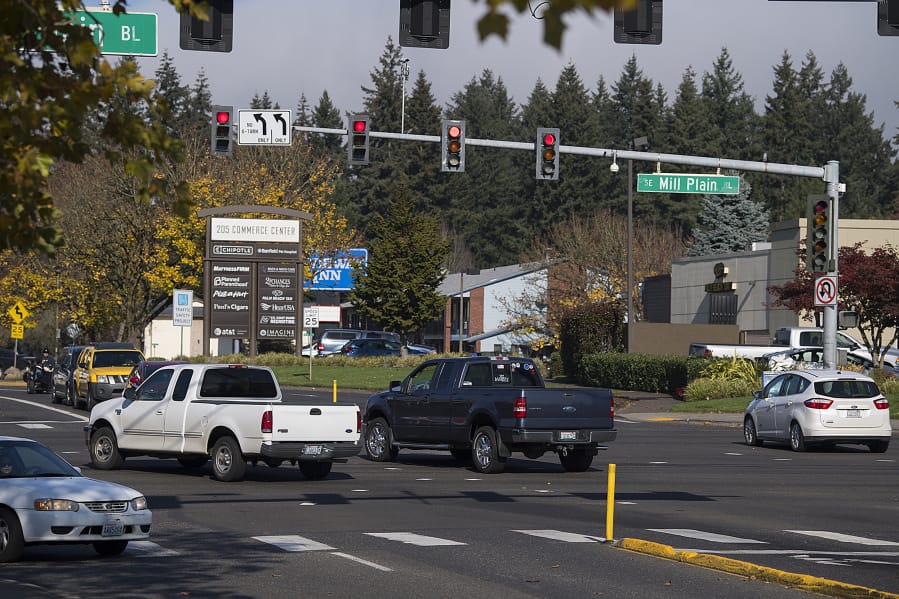There’s no correlating study to back this up, but red-light enforcement cameras are hated by practically everyone with a driver’s license.
Still, evidence from hundreds of communities in about two dozen states showed that intersections equipped with red-light cameras experienced substantial reductions in the number of collisions after they were installed.
The Insurance Institute for Highway Safety claimed red-light cameras saved 159 lives from 2004-08 in 14 of the biggest United States cities that had them in place.
Seattle has them. So does Tacoma. And — maybe some of you know this firsthand — Portland has them.
So why doesn’t Vancouver?
That was on the mind of at least one Columbian reader who posed the question to Clark Asks, the paper’s feature where you ask and we investigate.
Well, Vancouver almost had them — almost.
About 10 years ago, the city of Vancouver considered adding “photo red enforcement” cameras at an intersection to bust red-light runners.
The intersection of Southeast Mill Plain Boulevard and Chkalov Drive sat atop the list of likeliest places to get one, according to Columbian archives. The first lights would have been installed in August 2009, and, after a 30-day warning period, violators would have received a $124 ticket.
The city never actually followed through with the plan.
To many Vancouver citizens’ ire, the city of Vancouver approved the contract with a company to install red-light cameras around the city, but the company, American Traffic Solutions, unexpectedly backed out. The city then tried another vendor, but working with them wasn’t economically feasible.
“Some cities have very extensive red-light (camera) programs that catch enough people to pay for themselves,” Vancouver City Attorney Ted Gathe told The Columbian in 2011. “Vancouver was looking at it strictly where it was most needed.”
In subsequent years, the Mill Plain and Chkalov intersection was improved and removed a particularly problematic left turn, which made the cameras less necessary at that intersection.
If anything, the city’s outlook on red-light cameras soured in the intervening years.
Vancouver Police Department spokeswoman Kim Kapp said in an email, “Given our current plan, and our philosophy on community policing, red-light cameras are not something that we believe provides the best option for traffic enforcement.”
Instead, the department has opted to grow its traffic unit.
Kapp explained that once a red-light camera is in place, it can’t easily be moved to a newly problematic location; and unlike a cop, a camera just tickets drivers for running a light — it can’t tell a driver how they messed up and let them off with a warning. Plus, there is a public perception that red-light cameras are really for cashing in than protecting the public.
That dim view doesn’t stop in Vancouver. Many communities that installed them in recent years have started shutting them off.
While that might be comforting to scofflaws, it puts lives at risk, according to the Insurance Institute.
In an article published on its website in July, the Institute wrote, “the fatal red-light-running crash rate was 30 percent higher in cities that turned off cameras than it would have been if the cameras remained on. The rate of all fatal crashes at signalized intersections was 16 percent higher.”
Clark County Public Works traffic signals manager Robert D. Klug said the cameras have their critics and sometimes don’t always work like they’re supposed to.
He said he’s heard people claim that once drivers learn to not run the red lights, and therefore stop generating revenue to cover the costs of the cameras, traffic engineers tighten the yellow and red lights to further catch more drivers to keep paying for the traffic camera.
Conspiracy theories aside, he’s clear that he’s never met a single traffic engineer who’s actually done that.
Kapp also noted studies that conclude that red-light cameras contribute to different types of collisions. Rather than run a red and get a ticket, drivers jam on the breaks and get rear-ended — whereas people generally slow down when a cop is nearby.
Another issue Klug pointed to is, cameras can ticket drivers who turn right on red if they aren’t property calibrated.
Like Vancouver, the county doesn’t have a red-light camera enforcement system and doesn’t plan on creating one.
“Quite frankly, this issue hasn’t even been brought up during the past decade,” Klug wrote in an email. “Public Works hasn’t had any discussions with the Clark County Council to consider this type of system.”
Instead, county road planners are looking to brighter traffic signals and increased traffic data — which could lead to targeted law enforcement — to address red light runners and reduce congestion.
Klug pointed to newer and brighter LED indicator lights the county installed in all of its traffic signals. Certain intersections have seen fewer angle collisions since they were installed.
The county has also worked with the company that developed its traffic signal controllers to gather data on driver behaviors.
“One type of analysis is used to look for where drivers are regularly running red lights and determine if traffic signal timing changes could be made to reduce the number of red light runners,” Klug wrote. “If signal timing changes do not effect a change in driver behavior, then we would contact the Clark County Sheriff’s Office to see about targeted enforcement.”
Should the county ever seriously consider red-light cameras, they’d use a similar data and analysis approach to choose where to put them.
“Our goal is to reduce incidents that can occur by producing better information. Next year our better data will tell us if it’s occurring and can we make signal timing changes … that will make it so it doesn’t happen or reduces it significantly,” Klug said.
“If that doesn’t happen, we can work with the sheriff and do targeted enforcement.”



